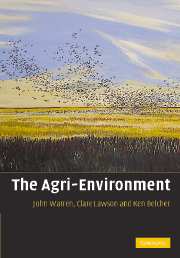Book contents
- Frontmatter
- Contents
- Preface and Acknowledgements
- 1 An introduction to agro-ecology
- 2 Agricultural support and environmentalism
- 3 Environmental impacts of agriculture
- 4 Principles behind agri-environment schemes
- 5 Farm conservation planning
- 6 Habitat management
- 7 The management of agricultural wastes
- 8 Low-impact farming systems
- 9 Landscape and farmscape ecology
- 10 The future of agri-environmental systems
- Glossary
- References
- Index
6 - Habitat management
Published online by Cambridge University Press: 08 December 2009
- Frontmatter
- Contents
- Preface and Acknowledgements
- 1 An introduction to agro-ecology
- 2 Agricultural support and environmentalism
- 3 Environmental impacts of agriculture
- 4 Principles behind agri-environment schemes
- 5 Farm conservation planning
- 6 Habitat management
- 7 The management of agricultural wastes
- 8 Low-impact farming systems
- 9 Landscape and farmscape ecology
- 10 The future of agri-environmental systems
- Glossary
- References
- Index
Summary
Introduction
The increasing use of inputs and the highly specialised types of farming systems practised nowadays have had a huge impact on both the agricultural landscape and species it supports (see Chapter 3). The abandonment of traditional farming systems and the expansion and intensification of agricultural production have resulted in the loss of many natural and semi-natural habitats. The integration of environmental objectives into agricultural policy (see Chapter 2) has encouraged the restoration of habitats of high conservation value and the creation of new ones. Various agri-environment schemes have been implemented where incentives are put in place to either encourage farmers to adopt management schemes that are environmentally beneficial, set-aside environmentally critical land or discourage or restrict management practices that are damaging to the environment (see Chapter 4). Enhancing the conservation value of agricultural land is currently attracting much research activity. This chapter reviews the scientific theory behind the maintenance of diversity, the assembling of communities and habitat management, and links between soil ecology and botanical diversity. Practical advice on what is possible/acceptable on farms will be provided. The application of habitat management to alleviate the problems of fragmentation will be considered in Chapter 9.
What is conservation value?
In theory, if any form of land management is carried out for long enough on a particular block of land with a particular climate and geology then a predictable, recognisable community of plants and animals will develop.
- Type
- Chapter
- Information
- The Agri-Environment , pp. 105 - 126Publisher: Cambridge University PressPrint publication year: 2007



